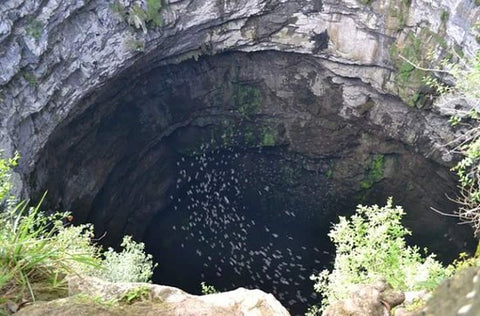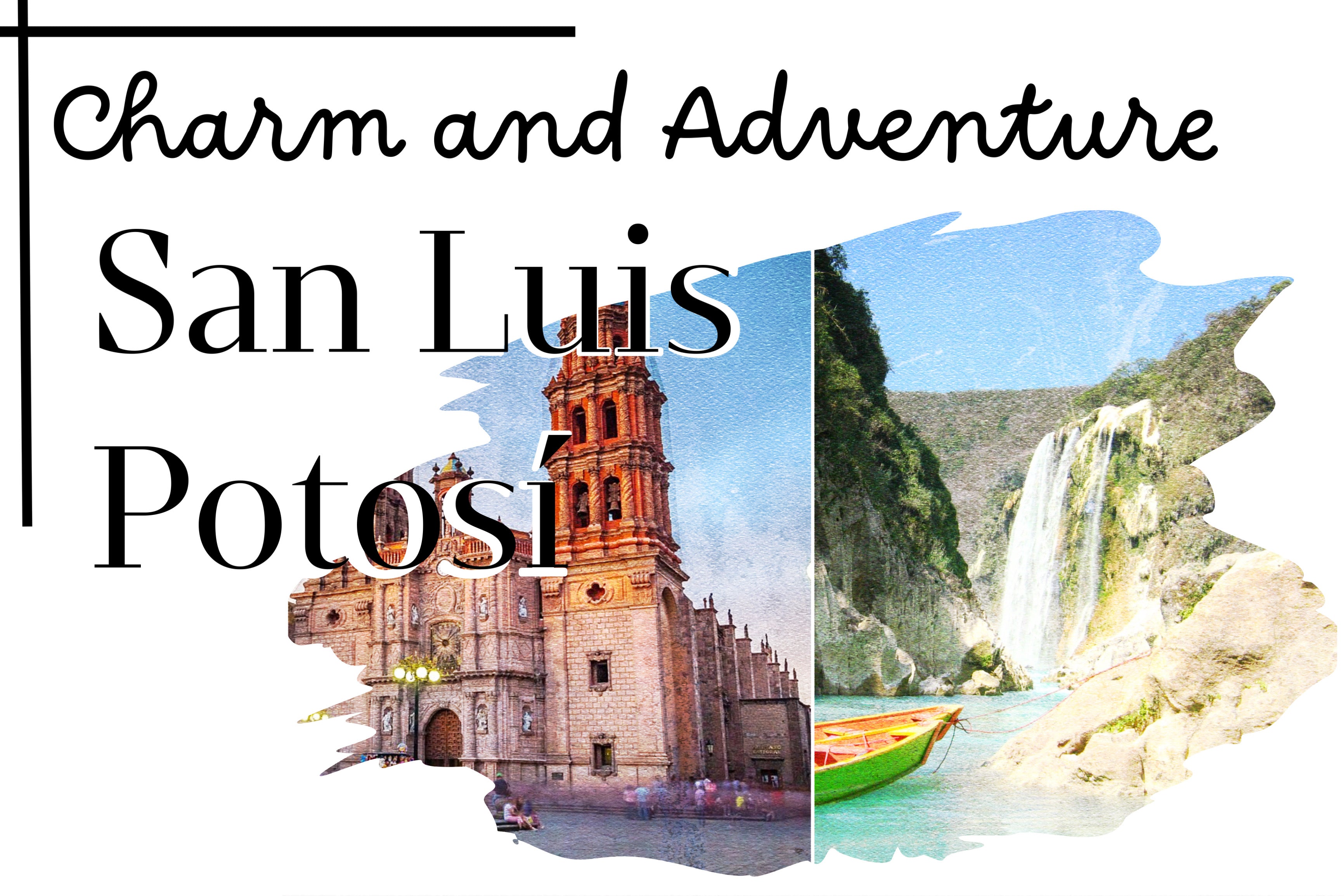One of Mexico’s least traveled and most beautiful states, San Luis Potosí is a state in central Mexico (a region known as El Bajío), and its capital is also named San Luis Potosí (San Luis Potosí city) abbreviated as SLP and sometimes called only San Luis. This beautiful state has everything to offer, from cultural richness of astonishing churches and colonial buildings, delicious food with an impressive history behind them, to the most impressive natural landscapes one can ask for. For us, this state is considered a hidden gem, and it is by far one of our most recommended places for those whose feet like to wander around looking for adventures. This travel guide will highlight both San Luis Potosí City and La Huasteca Potosina in the hopes of presenting the main attractions this hidden gem has to offer!

View of Plaza de Armas, San Luis Potosí Main Plaza.
Before Spanish colonization, the state of San Luis Potosí was inhabited mostly by Otomí and Chichimeca nomadic groups. With the arrival of the Spanish, several of these groups got displaced or deceased, but some Otomí, Náhua, Pame, and Huasteco groups still inhabit this territory. The city of San Luis Potosí traces its roots to 1592, when gold and silver deposits were discovered, triggering its establishment and providing the prosperity which it grew upon. Later, in the 17th century, Franciscan, Augustinians, and Jesuit missions established in the area, building churches and other structures that give the city its colonial charm. Today, most of the bigger and most famous buildings still stand and have been converted into museums and universities.
Being in any Mexican City, we always recommend starting the trip by visiting the city’s centre, downtown, walking around and sitting down at a local coffee shop or restaurants to soak up the city’s colonial charm and history (don’t forget to order some asado de boda, enchiladas potosinas, cabuches and campechanas to delight your palate!). For this, go to the main plaza, Plaza de Armas, and walk around visiting its beautiful cathedral and experiencing local life surrounded by street vendors. If you are looking for impressive colonial churches, don’t miss Templo del Carmen in what is known as Plaza del Carmen, which has an 18th century baroque architecture with a breathtaking multicolored tiled dome.

Plaza de Armas with a view of Catedral Metropolitana de San Luis Potosí
San Luis Potosí city has many museums which we recommend you make sure to visit. Out of them all, we recommend Museo Nacional de la Máscara, a specialized museum dedicated to the art of making masks and Museo Federico Silva, a showcase for the work of sculptor Federico Silva. A little further away there is also the Museo Leonora Carrington a tribute to the English-born Mexican surrealist painter; and the Museo Regional Potosino that also includes the famous Plaza de Aranzazu, worth sticking around for a variety of restaurants, coffee shops, and artisanal treasures being sold on the street. Lastly, try your best to visit the Cultural Art Center and the Museo del Ferrocarril, you will not regret this!
Let’s break down this part of Mexico first, before diving into the amazing natural attraction that is La Huasteca Potosina. La Huasteca is a region located along the Sierra Madre Oriental and the Gulf of Mexico. It includes parts of the states of Tamaulipas, Veracruz, Puebla, Hidalgo, Querétaro, Guanajuato, and, of course, San Luis Potosí. As we previously mentioned, before Spanish colonization, San Luis Potosí was inhabited by indigenous groups, one of them being the Huastec, which is where it gets its name from. Today, the Huastecs occupy only a fraction of this region with the Nahua people now the most numerous indigenous group. However, those who live in the region share a number of cultural traits.

El Salto Waterfall, in El Naranjo, San Luis Potosí.
Southeast of San Luis Potosí city, one can find the hidden natural wonder that is La Huasteca Potosina. What makes this place special is the natural playground it is with an innumerable amount of impressive waterfalls, canyons, natural pools, and caves. The best and most convenient way to travel to all of these places is by staying in Ciudad Valles, a charming, very small town where, although there is not much to see or do, people are as nice as they can be and ready to give advice on your travel around La Huasteca. You could also prepare your trip there by talking to local tour guides (which helps the economy of the place!) and reserving your tours.
Staying in Ciudad Valles, then you can reach the spectacular Tamul Waterfall, located in the Aquismon municipality, considered by many “the jewel of Potosinas waterfall.” To get there, you have three options: The first one an the one we recommend the most is departing from la Morena and taking a boat ride which will stop right in front of the waterfall, making this a breathtaking view; the second option is to depart from Tanchachín, taking another boat that lasts 2 hours along a river; and the third one is to depart from El Sauz, taking a short hike to appreciate the waterfalls from above. No matter what you decide to do, this will definitely be a sight to see. Around Tamul Waterfall you could also get more extreme activities such as rafting, kayaking down Tampaón River, or rappel down the surrounding mountains.

Tamul Waterfall, view from below.
Other famous waterfalls to consider are Temosopo and Puente de Dios Waterfalls, where you can jump into these waterfalls. You could also go to the El Naranjo municipality and visit all its surrounding waterfalls at once, including Micos River, El Salto del Meco, and Minas Viejas, all worth visiting.
If you are more into caves, La Huasteca also offers the most astonishing natural spectacles in El Sótano de las Golondrinas (Swallow’s Basement or Cave). This natural abyss, ranks seventh in the world and its opening is around 196 feet in diameter and its depth reaches 1,680 feet, with a free fall of approximately 1,230 feet. In this big cave, thousands of swifts, parrots and other bird species leave at dawn and enter at sunset the abyss circling as if they were a big whirlwind. This is definitely a show that you will hardly ever forget (also making it worth the climb of the 568 steps you have to take in order to get there!).

El Sotano de Las Golondrinas Cave with birds forming whirlpool by exiting at dawn.
Lastly, the small nearby town of Xilitla hides within a surreal garden of natural waterfalls and pools interspersed with towering surrealist sculptures in concrete structures. Also known as “Las Pozas”, the famous English poet and artist Edward James created this Surrealist Garden in the heart of the Magic Town of Xilitla, southeast of San Luis Potosí. Edward James came to Mexico in 1947 and was so impressed by this mystical place and its tropical forest that he bought land near the town, making it his home. After a frost, much of the property was destroyed and that was when James began construction of “his great dream”, the magnificent sculptural garden we know today.

Surreal magic town, Las Pozas in Xilitla, San Luis Potosí.
---
So, what do you think about San Luis Potosí? Is this a place you have visited or would like to visit? What part of San Luis Potosí interested you the most? It is almost impossible for us to mention all there is to see, as the geography of the region makes this for a varied and countless landscapes. However, we hope that this list full of places definitely worth visiting encourages you to explore this exceptional awe-inspiring wonder!
Also, don't forget to subscribe to our newsletter where we make sure to share this and many more travel tips, stories, recipes, and content of interest. We also make sure to give our familia of subscribers exclusive promotions, gifts, first-hand look at all new products and, of course, these articles that we love to write for you all!









1 comment
Faye Krygsheld
Me encanta la informacion acerca de las ciudades que yo no tuve la oportunidad de visitar. Gracias.